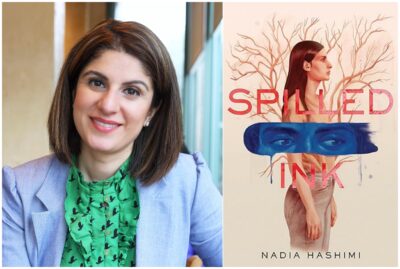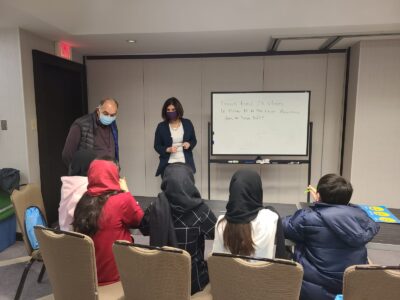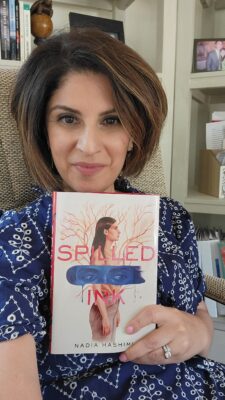
Nadia Hashimi, the internationally best-selling author of unforgettable, powerful and heart-wrenching books like The Pearl that Broke its Shell and A House Without Windows, brings us her first young adult novel, Spilled Ink.
No stranger to complex, challenging and often controversial themes, with Spilled Ink, Nadia brings us a thought-provoking exploration of dual identities, intolerance, racism and community. The YA book centers around the lives of Afghan/American teens Yalda and Yusuf. The twins’ lives are forever altered when Yusuf, in a courageous but impulsive act, confronts racism in their suburban Virginia town. A hasty joke that goes viral online not only threatens their livelihood and reputation but also endangers their lives. In a town that no longer feels safe, Yalda’s resilience is tested as she navigates the backlash, and her story reveals that it is often through challenging times that we find our voice and discover allies in unexpected places.
My admiration for the author and her work is no secret. My favourite kinds of stories are ones I am emotionally moved by, stories that are compelling, engaging and encourage introspection. Not only do Nadia’s books deliver on all fronts, but as a reader, I am also captivated by her skilful use of rich and evocative prose and vivid descriptions that transport me into the lives of her characters.
Apart from being an extraordinary storyteller, she is also an excellent conversationalist. Speaking with Nadia Hashimi is rewarding, always an honour, and a gift for which I am grateful.
Nadia, let’s start with your book’s title. How did you come up with it, and what does “Spilled Ink” signify?
Let’s start with an acknowledgement that Spilled Ink is only the second book that I’ve titled. My other works have been titled by my agent, Helen Heller, who has a remarkable ability to pluck evocative titles from lines of Sufi poetry. What I love about titles is that they invite interpretation. For me, the ink represents Yalda’s self-expression. When we meet Yalda, she keeps her voice bottled up, but as the story unfolds, she’s pushed to find her voice. The bottle tips, Yalda is heard in new ways, and we get our title.
How did the writing process for this book differ from your others? Did anything unusual or surprising crop up as you were drafting the manuscript?
I started writing this story before the August 2021 fall of Afghanistan. That month, I was pulled into the world of people advocating for the evacuation of vulnerable Afghans, people who had worked with the Afghan government, women’s rights activists, journalists, interpreters who had served with international troops, and other individuals who were at high risk of being targeted for reprisals by the Taliban. My amazing editor, Rosemary Brosnan, generously gave me extra time to get this manuscript to her. I envisioned Yalda and Yusuf living in a town that had mixed feelings about immigrants but in a general way. When I started to see the spectrum of reactions to Afghan families being resettled across the United States, this piece clicked into place and gave the story more specific context.
The concept of dual identity is very prominent in your book. How much of Yalda’s story mirrors your own? Have you ever felt torn between your two identities, Afghan and American?
While I never try to write myself into a story or have any characters bear significant likeness to me, it would also be hard not to share some common experiences with someone like Yalda. We both grew up in the United States, born to Afghan parents. Both of us worked in our family food businesses – a restaurant for her and a deli for me. And both of us have had to consider which aspects of our culture we want to honor and carry with us, and which aspects could use some modifications. I tend to think my characters demonstrate more courage and ingenuity than I might were I in their shoes and that’s the fun part of writing for me. Looking back, I think I’ve gone from feeling like two identities stitched together to feeling whole, the seams no longer visible.
You’ve often said you write the stories you wish you could have read growing up. Tell us about the importance of representation in Spilled Ink, knowing that Afghan refugees and immigrants now have a book that reflects some of their experiences.
In my childhood, I grew up with the stories my relatives would tell during gatherings – the challenges they faced during their journeys, the mistakes they made while getting their bearings in a new land while learning a new language, and the homesickness that would linger for a lifetime. There is much that is universal in the experience of an immigrant, but I really enjoy exploring the nuance of the Afghan experience. And I love that some of the newly arrived children will be able to specifically see themselves in this story. I hope it makes them feel a bit more welcome.
You say something very powerful in this book: “After forty years of fighting, ‘Afghan’ and ‘Refugee’ is almost the same thing.” From all your work with refugees, what would you say are their biggest struggles? Is there anything you want people to know that needs to be more widely understood?
Every refugee’s experience will be nuanced and different in some ways, but the immediate and major challenges have been finding affordable housing, adjusting to a new location away from family and friends, securing employment with a salary that can support a family, worrying about loved ones left behind, and adjusting to a new culture and system. The rate of psychological distress (PTSD, anxiety, depression, etc) are high in the Afghan population. Adding displacement to that mix created a lot of exacerbations of mental health issues, and there simply are not enough resources to get everyone the help they need. Long term, there are other challenges. Children often learn the language faster than their parents, and those insecurities and dependencies can upset family dynamics.

Recently, in an interview, you said, “We undermine what fiction can do. It can change the way we see conflict.” Could you speak to us about the relevance of fictional stories during times of war and unrest? How can they be used as a tool for peace?
Let’s start with the truth that history is written by the victors. The Thanksgiving story of the pilgrims and Native Americans breaking bread together as a representation of America’s origin story is a great example of this. But to have a more accurate record of a conflict, to better understand the impact on populations, we need to pay attention to different narratives. We cannot avoid narratives that make us uncomfortable or challenge simplified teachings. If there’s a side of a story that is not being told, we have to ask why. Peace will never come from a false interpretation of a conflict. When the United States withdrew from Afghanistan, the people in charge changed the narrative. After twenty years of battling the terrorist Taliban, the United States pivoted overnight and announced that the Taliban would help us address the real terrorists – ISIS. Liberating Afghan women from Taliban oppression went from being our battle cry to utterly insignificant. And we can never expect to see peace in Afghanistan if the Afghan people are not given space to talk about the impact the conflict has had on them and why the country fell back into the hands of the insurgents.
In your acknowledgements, you mention your older son contributing a line for the book and your older daughter contributing one of her own experiences. How does it feel to have their involvement in your writing process? Will there be future collaborations?
When my children are not interrupting my writing, they are inspiring it. I want to write stories that they can be proud of and that they can be part of. They ask me often what I’m working on and, when I’ve done classroom visits in their schools, they’ve been tickled (and maybe baffled?) to see their classmates want to hear about the writing process from me. If there are writing collaborations in our future, that would be great. But mostly, I hope that they are seeing how fulfilling it can be when work and passion come together.
This is a question every devoted fan wants to ask. What are you working on next?
I’ve just recently signed a deal to publish A City of Widows, which will be a sequel to The Pearl That Broke Its Shell. The story is set in Kabul during the 2021 evacuation and fall of the country. I really have had no intention of writing a sequel to this story despite the many inquiries from readers, but the main character, Rahima, has been on my mind quite a bit lately, and I am not one to ignore a friend’s call.
The Pearl that Broke its Shell, your first book, celebrated its 10th anniversary in May. Seven books, ten years. Can you share some memories that stand out from your writing career so far?
I must thank you for pointing out to me that this year marked the 10th anniversary for The Pearl That Broke Its Shell. I feel so fortunate to have had a decade of these stories being so warmly welcomed in libraries and homes, of people gathering with friends to spill their feelings about the characters and even inviting me to be part of the conversations. And more than anything, I’m grateful for the compassion readers have demonstrated. Shikha, you’re a remarkable model for us all. You have become a real-life heroine to so many vulnerable people and found ways to blend art and humanitarianism. The connections the stories have made for me with people around the world is a precious gift.
In this bonus video segment, Nadia answers the questions of five young readers from around the globe.
She talks about writing, her journey as an author, and more.


Nadia Hashimi
Nadia Hashimi is an internationally bestselling author, making her YA debut with Spilled Ink. Her previous novels for adults and children draw inspiration from the complex history of Afghanistan and the struggles and resilience of her people. Her writings on Afghan women and the fall of Afghanistan have also been featured in Ms Magazine, NPR, and Mother Jones. During Operation Allies Welcome, she consulted for the US Committee for Refugees and Immigrants to help design and implement a psychosocial support program for Afghan evacuees. Since then, she has also run narrative writing workshops for refugees. She is a board member of Sahar Education for Girls, Aschiana Foundation, and is a member of the US Afghan Women’s Council and Welcome.US. Originally from New York, she lives with her husband and four children in Potomac, Maryland.

What a great feature on this author! She sounds amazing, as does her book which I will have to add to my growing reading list. Thanks for sharing a bit about Nadia Hashimi’s work, etc.!
Molly | transatlanticnotes.com
Molly, Thank you so much for reading. Glad you enjoyed the interview.
Very interesting read indeed I feel compelled to read her new book shikha thanks for the informative questions n answers
Thank you so much, for reading 🙂